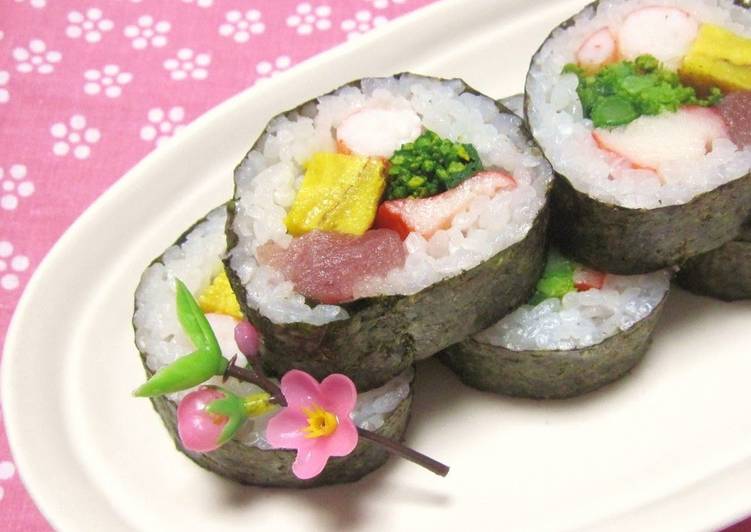Doll's Festival Seafood Futomaki Sushi Rolls with Nanohana. Futomaki or Maki Sushi is a traditional thick and fat sushi roll typically filled with vegetables and sometimes include cooked fish like unagi. You can make this sushi roll ahead of time and bring to festivals, potlucks or picnics. When I ask people what's their favorite sushi, the answers I often get.
 It is much thicker than Tuna rolls or cucumber Today eating Futomaki is a more commercial than traditional function like a lot of other festive events.
Futomaki in Setsubun is also called Ehoumaki. <p>Futomaki is a kind of sushi roll having a variety of fillings such as vegetables and seafood (cooked).
It is much thicker than Tuna rolls or cucumber rolls, and the fillings are cooked and flavored, thus you don't really need to dip in soy sauce (unless you want to).
You can have Doll's Festival Seafood Futomaki Sushi Rolls with Nanohana using 12 ingredients and 10 steps. Here is how you cook it.
It is much thicker than Tuna rolls or cucumber Today eating Futomaki is a more commercial than traditional function like a lot of other festive events.
Futomaki in Setsubun is also called Ehoumaki. <p>Futomaki is a kind of sushi roll having a variety of fillings such as vegetables and seafood (cooked).
It is much thicker than Tuna rolls or cucumber rolls, and the fillings are cooked and flavored, thus you don't really need to dip in soy sauce (unless you want to).
You can have Doll's Festival Seafood Futomaki Sushi Rolls with Nanohana using 12 ingredients and 10 steps. Here is how you cook it.
Ingredients of Doll's Festival Seafood Futomaki Sushi Rolls with Nanohana
- You need 2 of bowls Sushi rice.
- It's 3 of sheets Nori seaweed.
- It's 250 grams of Tuna (sashimi grade).
- It's 9 stick of Imitation crab sticks.
- It's 9 of flowers Nanohana.
- Prepare 9 of pieces Steamed shrimp.
- It's of For the Edo-mae tamagoyaki (traditional rolled omelet for sushi).
- Prepare 4 of Eggs.
- Prepare 2 tbsp of ●Sugar.
- It's 1 tbsp of ●Mirin.
- Prepare 1 tbsp of ●Sake.
- It's 1/2 tsp of ●Soy sauce.
These large sushi rolls use a full sheet of nori seaweed to enclose generous fillings. Add a row of sea sticks, then a row of shredded lettuce. On top of the shrimp, place slices of avocado and shredded carrots so the ingredients are piled like logs of wood. Futomaki is a variety of rolled sushi that is characterized by its large size and a strict balance of The rolls are typically filled with vegetables of different colors, and usually don't contain seafood.
Doll's Festival Seafood Futomaki Sushi Rolls with Nanohana step by step
- Add sushi vinegar to freshly cooked rice inside the rice cooker and mix it quickly. Transfer to a shallow dish, and cover with a dampened cloth once it has cooled..
- Microwave the ● ingredients, mix together thoroughly, and let cool. If you don't have dashi broth, just add a little bit of dashi stock granules to water..
- Coat a pan with oil (not listed), and make a tamagoyaki. Wrap up in a bamboo sushi mat to let it cool and shape it. The tamagoyaki won't cook through if you cook it in low heat, so be careful..
- Quickly boil the broccolini, and shock it in ice water. Throughly squeeze out the water..
- Cut a slit into the stomach of the shrimp to straighten it out, as you would when making deep fried shrimp..
- Wet your hands with water, and place 1/3 of the sushi rice on top of a sheet of nori seaweed. Make sure not to spread out both of the ends too thinly. It will thin out when you wrap it..
- Lay the delicate broccolini, shrimp, and imitation crab in the center. Lay the tuna and tamagoyaki on top..
- Use the front end of the rice to wrap up the ingredients, and roll up after squeezing tightly..
- You will get a cleaner cut if the rice and ingredients are tightly packed together, so let it sit for a while wrapped in the sushi mat..
- When cutting, cut the rolls by moving the knife back and forth in a sawing motion, and wipe the blade with a wet cloth between each cut..
Futomaki originated in Kansai as a festival food, and the most common way to eat the dish is with. Futomaki is a kind of sushi roll. In Japan, you may hear these big, thick sushi rolls referred to as makizushi (rolled sushi) or norimaki (sushi rolled However, not all futomaki are vegetarian. When these short, fat sushi rolls contain raw seafood, they traditionally include ingredients like tobiko. Autor: Michael Dechev. futomaki smakosz zdrowy japonia japonka japończyk japoński japońskie język japoński jeść obiad danie mączka posiłek talerz porcja bądź gotów czuwaj raw ryż roll rząd wiersz seafood glon wodorost przekąska sushi tradycyjne vegetables.